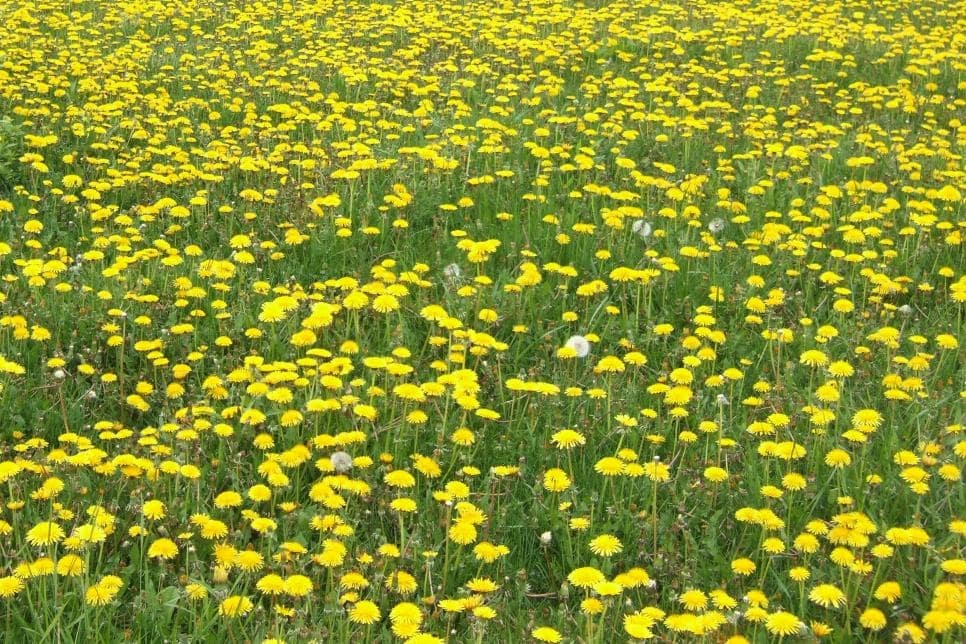
Have you ever stopped in a field of yellow flowers to take a dreamy picture? Chances are, these yellow flowers grew out of weeds!
That said, an instagrammable photo for one is, on the other hand, a headache to gardeners and farmers.
Here is a comprehensive list of tall weeds with yellow flowers to help you recognize them the next time you see one.
1. Yellow Toadflax (Linaria vulgaris)
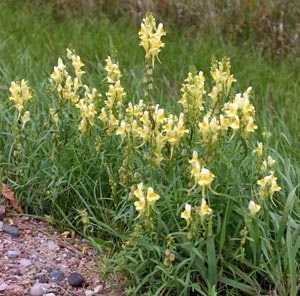
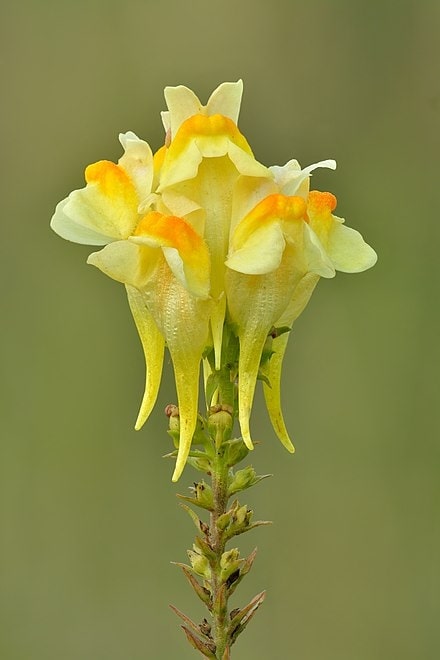
| Scientific Name | Linaria vulgaris |
| Common Name | Common toadflax, yellow toadflax, butter-and-eggs, wild snapdragon |
| Weed Type | Perennial weed |
| Flower | Bright yellow flowers in crowded terminal clusters |
| Leaves | Lance-shaped, stalklessGrows in an alternate manner |
The Yellow Toadflax is a perennial weed that thrives on disturbed and cultivated land and roads. It is native to Europe, Central Asia, Siberia, and North America.
The leaves of Linaria vulgaris are lance-shaped, stalkless, and pointed on both ends.
During mid-summer and mid-autumn, the yellow toadflax produces bright yellow flowers with an orange spot on its lower lip.
However, it is a noxious weed as it contains glucoside that causes livestock poisoning.
2. Grass-leaved Goldenrod (Euthamia graminifolia)
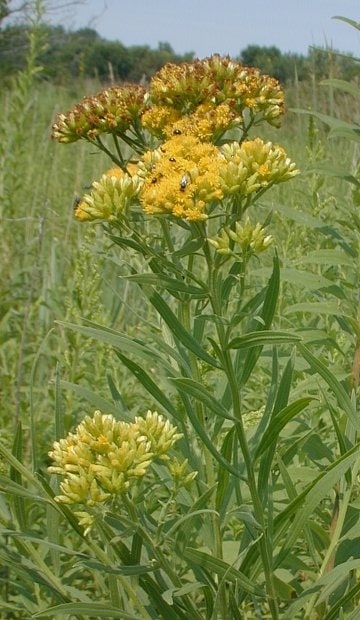
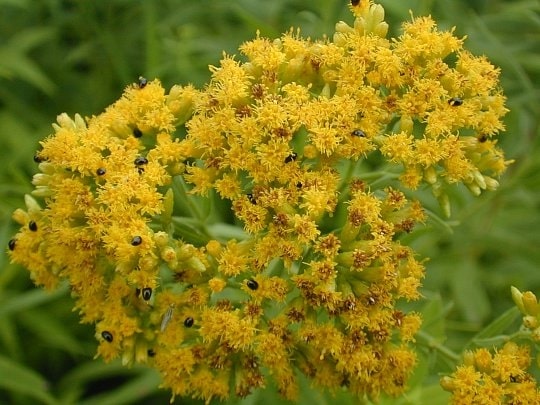
| Scientific Name | Euthamia graminifolia |
| Common Name | Grass-leaved goldenrod, flat-top golden top |
| Weed Type | Perennial weed |
| Flower | Shiny yellow flowers in rounded flat top clusters |
| Leaves | Green, long Grows in an alternate manner along the stem |
The grass-leaved goldenrod is a perennial weed indigenous to North America, Europe, and Asia.
It has a thin and long stem that grows up to 1.2 meters.
During late summer to early fall, it produces clusters of shiny yellow flowers on the upper side of its stems.
3. Sow Thistle (Sonchus arvensis)

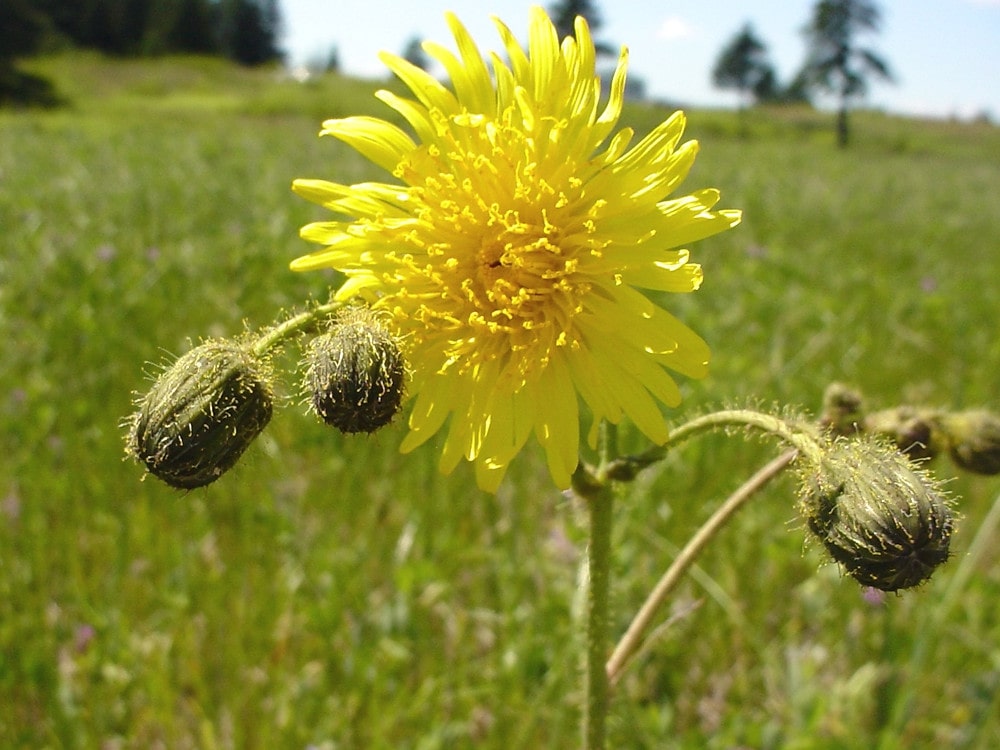
| Scientific Name | Sonchus arvensis |
| Common Name | Field milk thistle, field sowthistle, corn sow thistle, gutweed, swine thistle |
| Weed Type | Perennial weed |
| Flower | Yellow ray flowers in clustered heads |
| Leaves | Large, alternate and lobedEmit milky sap when cut |
The sow thistle is a perennial weed commonly found in Europe. It adapts to various environments – from lakes, marshes, and beaches, to woodlands, lawns, and fields.
It first develops a basal rosette. The lower leaves then grow into five lobes with prickly teeth in an alternate manner.
As the sow thistle matures, the midvein of the leaves thickens which contains a milky sap.
This plant has an erect, herbaceous stem with smooth ridges on the outside and a milky sap on the inside.
The sow thistle produces bright yellow ray flowers in clustered heads.
Unfortunately, it is considered a noxious weed because once it emerges, it causes crop yield losses to farmers.
4. Skeleton weed (Chondrilla juncea)
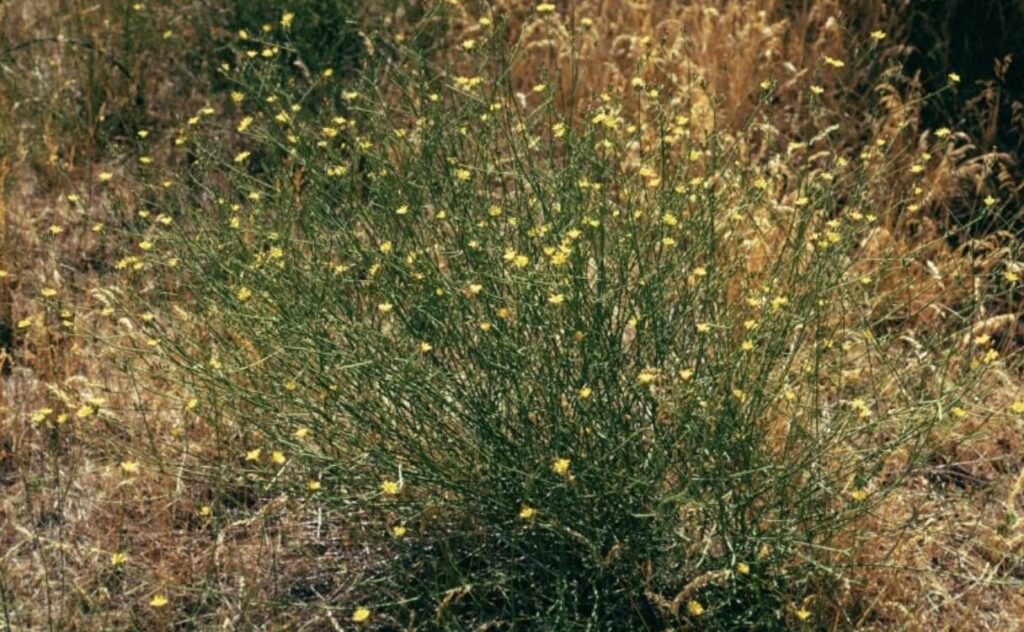
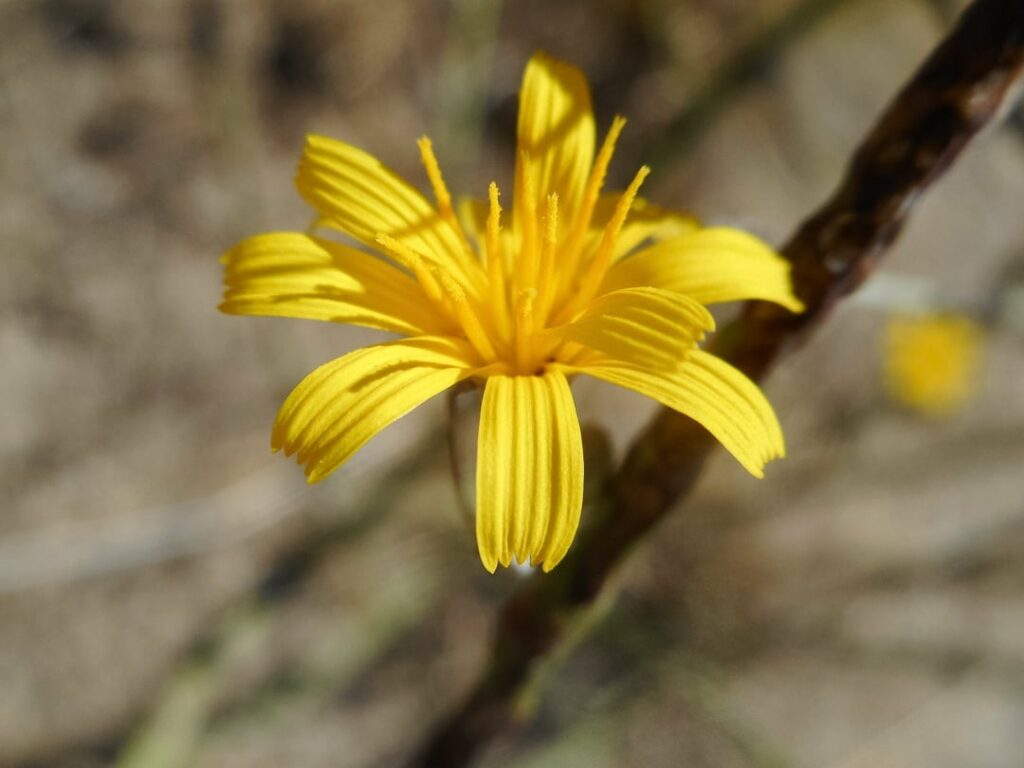
| Scientific Name | Chondrilla juncea |
| Common Name | skeleton weed, devil’s grass, gum succory, naked weed |
| Weed Type | Perennial weed |
| Flower | Daisy-like yellow flowers |
| Leaves | Sharply-lobed leaves |
Skeleton weed is a perennial weed native to the temperate regions of North Africa, Asia, and Europe.
It is usually mistaken for dandelions because of its basal rosette of leaves. But as it develops, its main flower and leafless stem branch out.
Skeleton weed flowers, which are small and daisy-like, grow on the side and at the top of the stem during summer and fall.
It’s a headache in agricultural fields because it competes with water and nutrients against other plants.
5. St. John’s Wort (Hypericum perforatum)

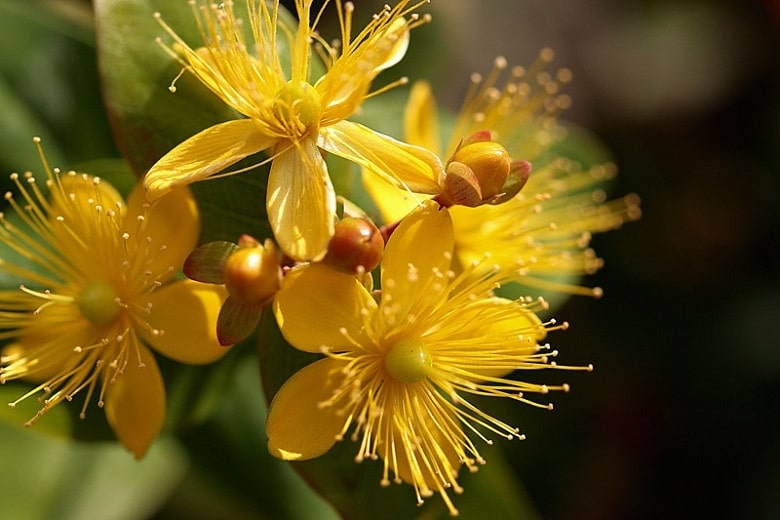
| Scientific Name | Hypericum perforatum |
| Common Name | St. John’s Wort |
| Weed Type | Perennial weed |
| Flower | Yellow flower with 5 petalsBlack dots scattered on the surfaceYellow stamens visible in the center of the flower |
| Leaves | Yellow-green leaves with translucent dotsNarrow, rounded tips |
St. John’s Wort is a perennial weed that thrives in the temperate regions of South Africa, Australia, America, Europe, Asia.
It has been used as a natural treatment for wounds, burns, anxiety, and even depression. In some cultures, this plant is used to ward off evil spirits.
Its upright reddish stems grow up to a meter tall. On top of it, bright yellow flowers emerge between late spring and mid-summer.
St. John’s Wort flowers each have 5 yellow petals with black dots, and yellow stamens emerging from the center.
On the other hand, its leaves do not have stalks but possess scattered translucent dots on their yellow-green surface.
6. Spanish Broom (Spartium junceum)
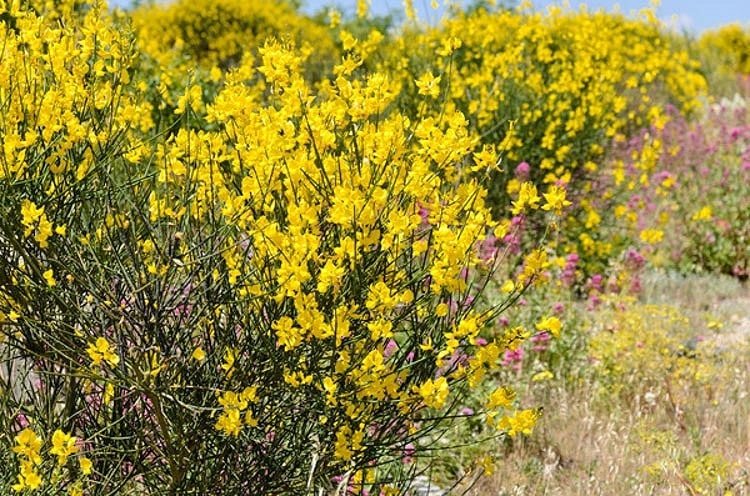
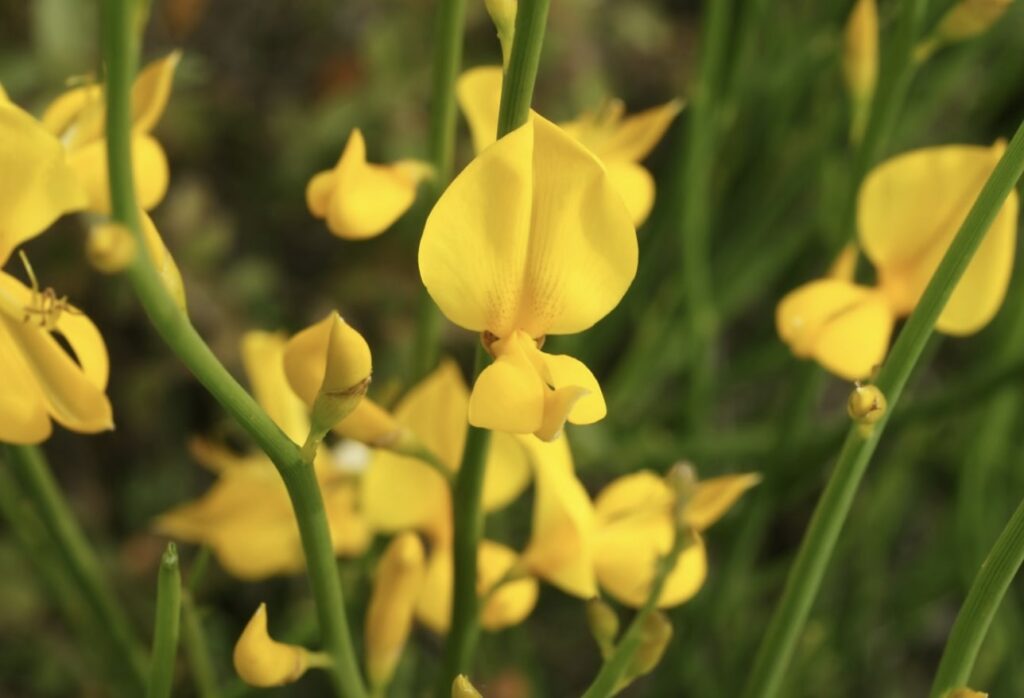
| Scientific Name | Spartium junceum |
| Common Name | Spanish broom, rush broom |
| Weed Type | Perennial weed |
| Flower | Fragrant pea-like flowers |
| Leaves | Oval, elongated and smooth-edged |
The Spanish broom is a perennial weed native to the climate of the Mediterranean region.
It is found in the wetlands, grasslands, and roadsides of northwest Africa, southern Europe, and southwest Asia.
The Spartium junceum has a soft, green, and cylindrical long stem.
On both sides of the main stem, a cluster of fragrant pea-like flowers bloom from late spring up to early summer.
7. Garden Loosestrife (Lysimachia vulgaris)
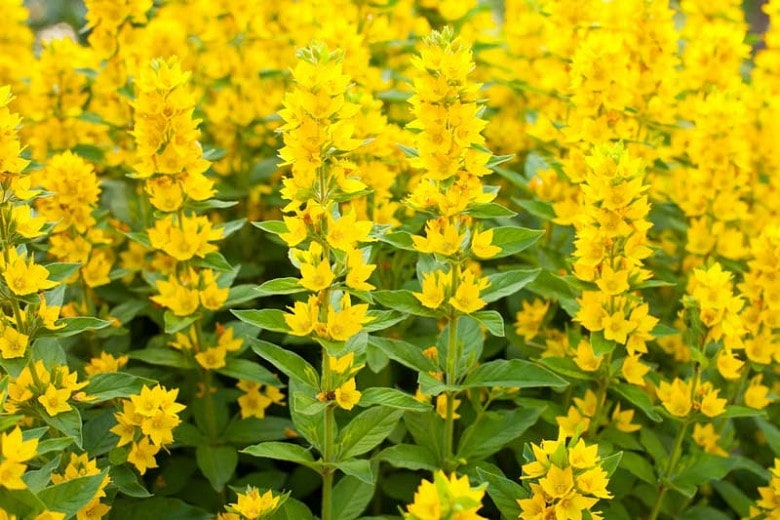

| Scientific Name | Lysimachia vulgaris |
| Common Name | garden loosestrife, yellow loosestrife |
| Weed Type | Perennial weed |
| Flower | Clusters of yellow flowers |
| Leaves | Lance-shapedWith soft hairs |
The Garden Loosetrife is a perennial weed indigenous to the moist stream banks, wetlands and shorelines southeast of Europe.
It blooms during the summer, producing dense clusters of yellow flowers on top of an upright and hairy stalk.
8. Ragwort (Jacobaea vulgaris)
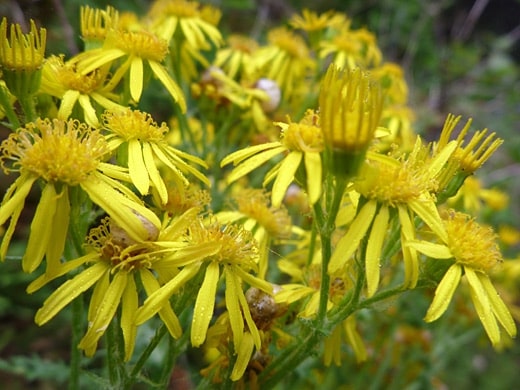
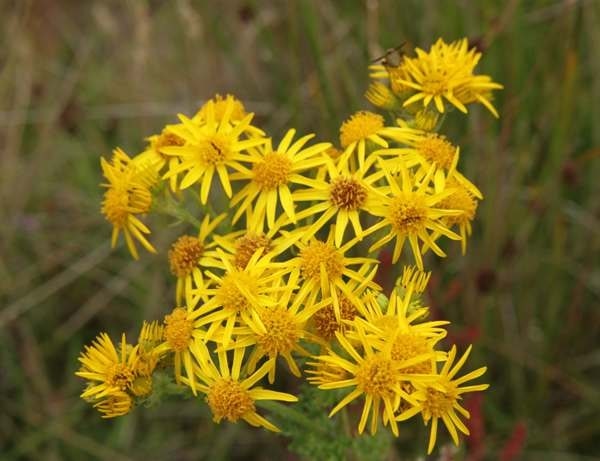
| Scientific Name | Jacobaea vulgaris |
| Common Name | Ragwort, common ragwort, Jacobaea, tansy ragwort, benweed, staggerwort, dog standard, cankerwort, stammerwort |
| Weed Type | Biennial weed |
| Flower | Yellow flowers that grow in clustersProduces 2,500 flowers in its lifetime |
| Leaves | Dark greenEar-like lobesDistinct unpleasant odor |
The ragwort is a biennial weed native to northern Europe and Asia. It thrives on dry and open areas like roadsides, trails, and pastures.
It is a noxious wildflower known for having toxic compounds that cause sickness to livestock.
Just like other tall weeds, the ragwort begins with a basal rosette which turns into an upright stem with a dense cluster of yellow flowers at the top. It can grow up to 2 meters.
One ragwort plant can produce up to 2,500 yellow flowers in its lifetime. They produce nectar that feeds thousands of pollinating insects.
9. Butterweed (Packera glabella)
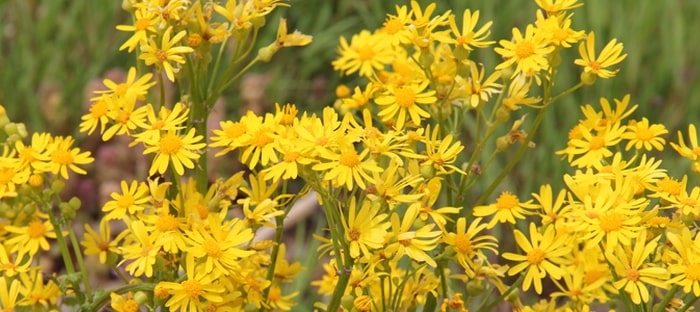
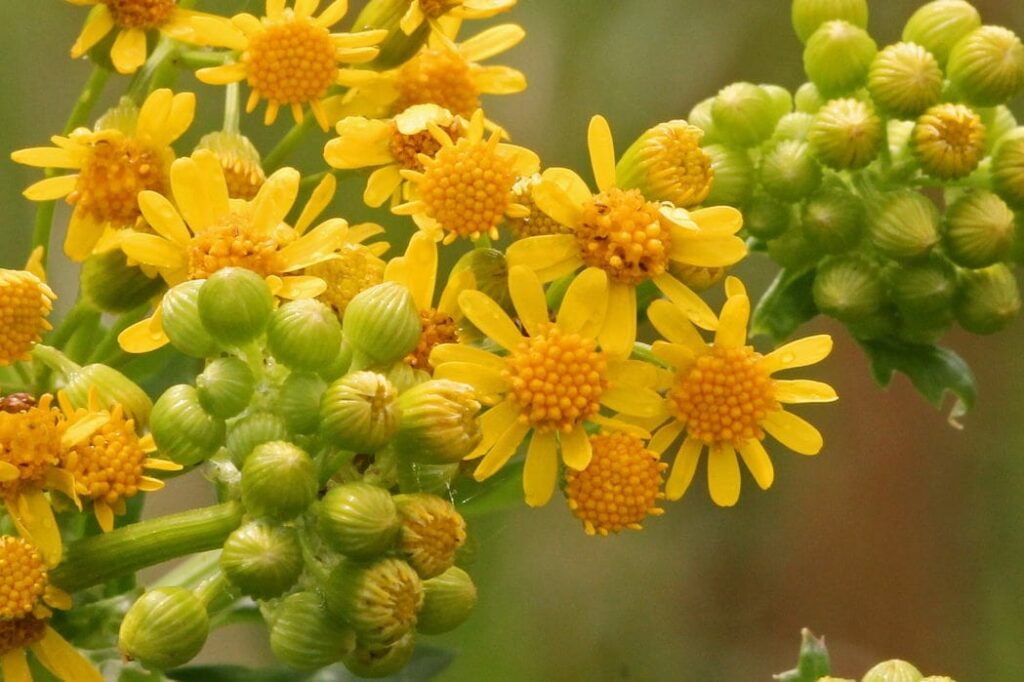
| Scientific Name | Packera glabella |
| Common Name | Butterweed, cress leaf groundsel, or yellowtop |
| Weed Type | Annual weed |
| Flower | Daisy-like flowers |
| Leaves | Green, alternate, pinnate leaves with large terminal leaflets |
Butterweed is an annual weed native to places with high humidity in central and southeast North America.
It is commonly found emerging in large clusters in roadsides, streams, forests, swamps, ponds, and agricultural fields.
In its early years, butterweed first grows basal leaves until it becomes a hollow stalk with yellow daisy-looking flowers at the top. Butterweed blooms from April to June.
However, the leaves and other parts of this plant contain a toxic chemical called alkaloids. These cause liver damage to whoever ingests them.
10. Wintercress (Barbarea vulgaris)
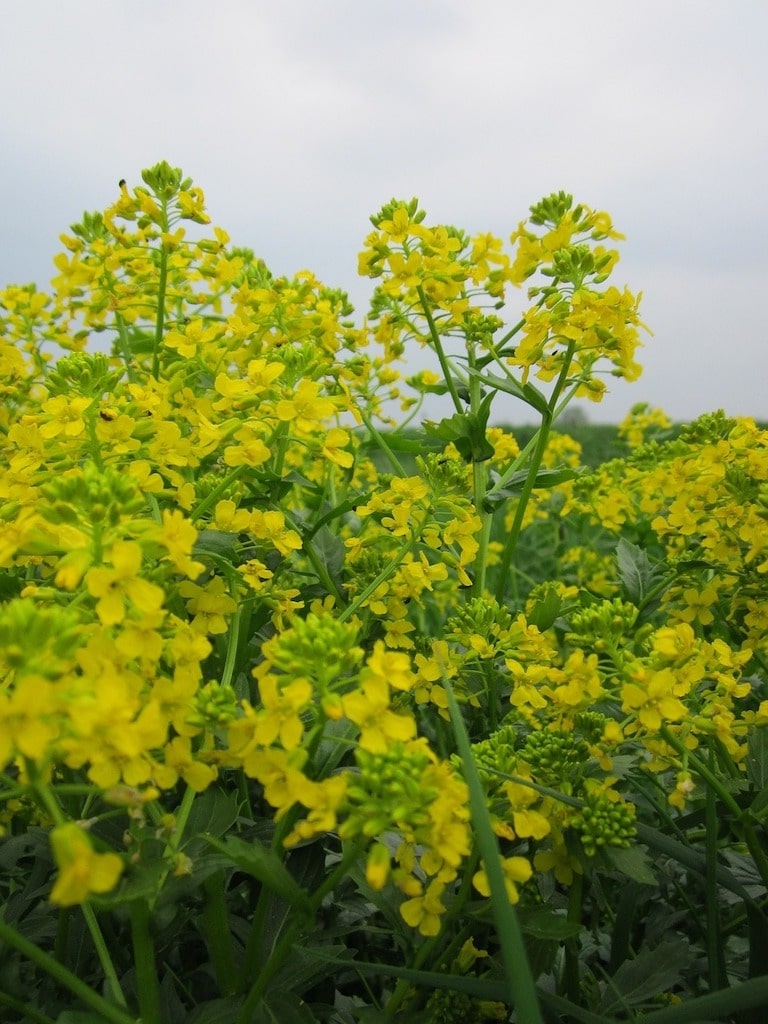
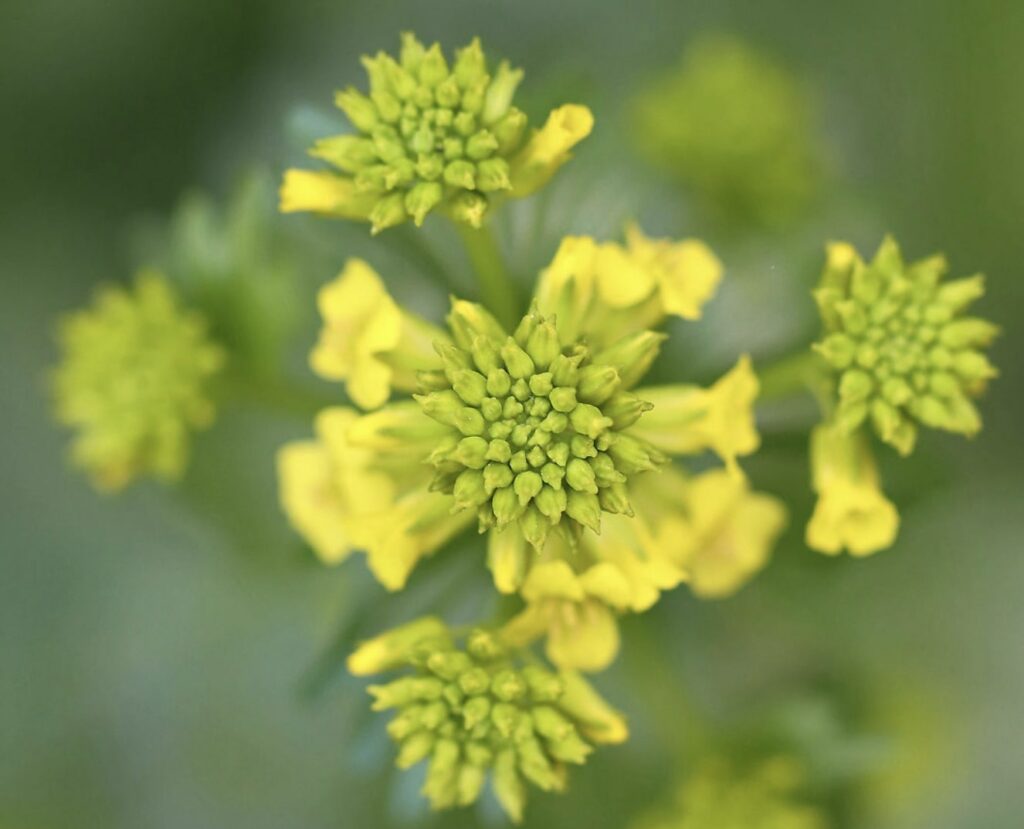
| Scientific Name | Barbarea vulgaris |
| Common Name | Wintercress, yellow rocket cress, winter rocket, herb barbara, rocket cress, wound rocket |
| Weed Type | Biennial weed |
| Flower | Dense cluster of small yellow and lightly fragrant flowers with 4 petals |
| Leaves | Deeply-toothed rounded leavesGrows in 1 to 4 pairs of lateral lobes |
The wintercress is a biennial weed indigenous to North Africa, Europe, and Asia. It is commonly found on roadsides, stony slopes, hay fields, rocky outcrops, and even waste grounds.
Wintercress first produces basal leaves, but in the second year, upright stalks grow with a cluster of yellow flowers at the top. Its flowering period is usually from the months of April to July.
The leaves grow large at the bottom and get smaller toward the top, giving the plant an oval shape.
Wintercress also produces small elongated green fruits which help propagate the plant with its tiny seeds.
11. Bird’s Foot Trefoil (Lotus corniculatus)
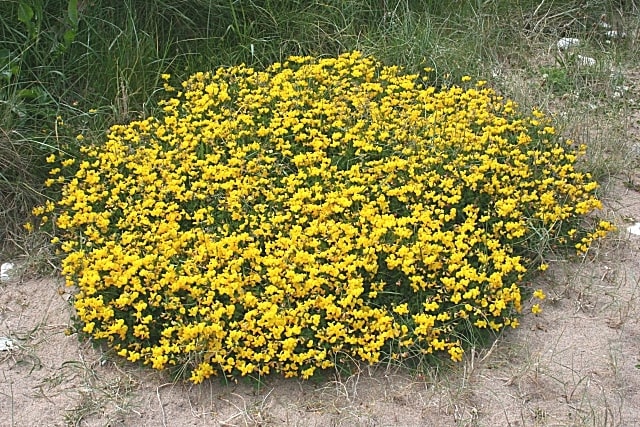
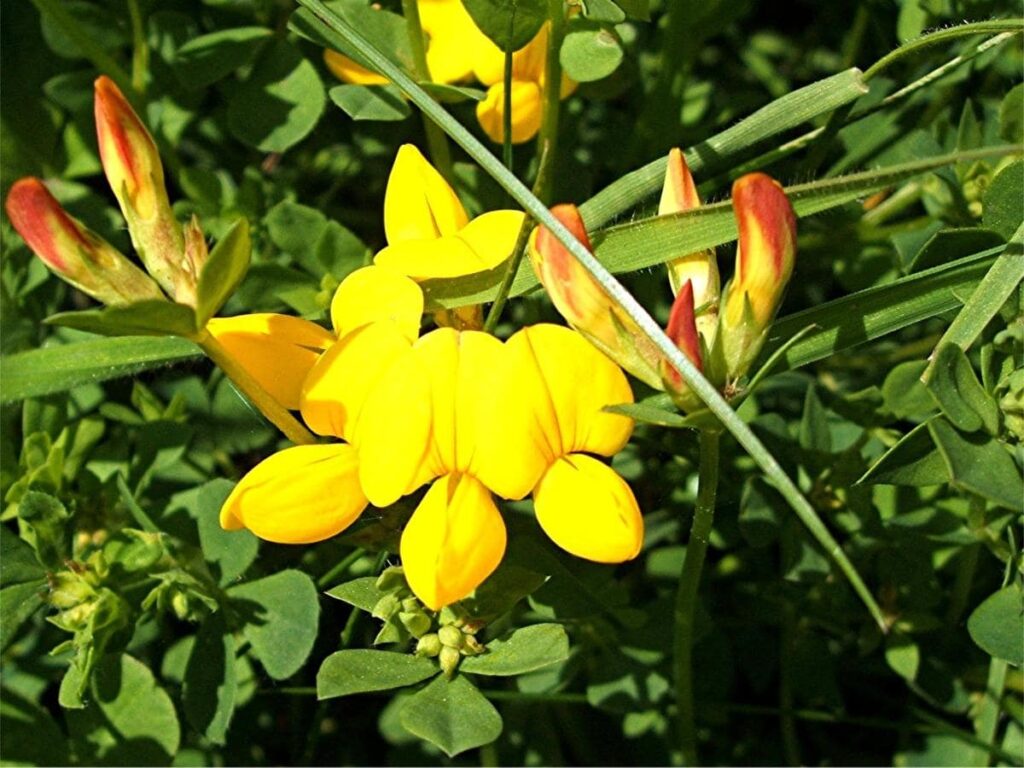
| Scientific Name | Lotus corniculatus |
| Common Name | Common bird’s-foot trefoil, bird’s-foot trefoil, birdsfoot deervetch |
| Weed Type | Perennial weed |
| Flower | Pea-like yellow legumes |
| Leaves | Compound and alternate leaves |
Bird’s Foot Trefoil is a perennial weed that is native to the temperate regions of Europe, Asia, and North Africa. This plant thrives in places with high precipitation and moderately acidic soil.
It produces pea-like, yellow flowers that emerge in a whorl pattern.
They are useful for erosion control, especially in mine reclamation, as well as a good source of food for wild deer.
12. Black-Eyed Susans (Rudbeckia hirta)
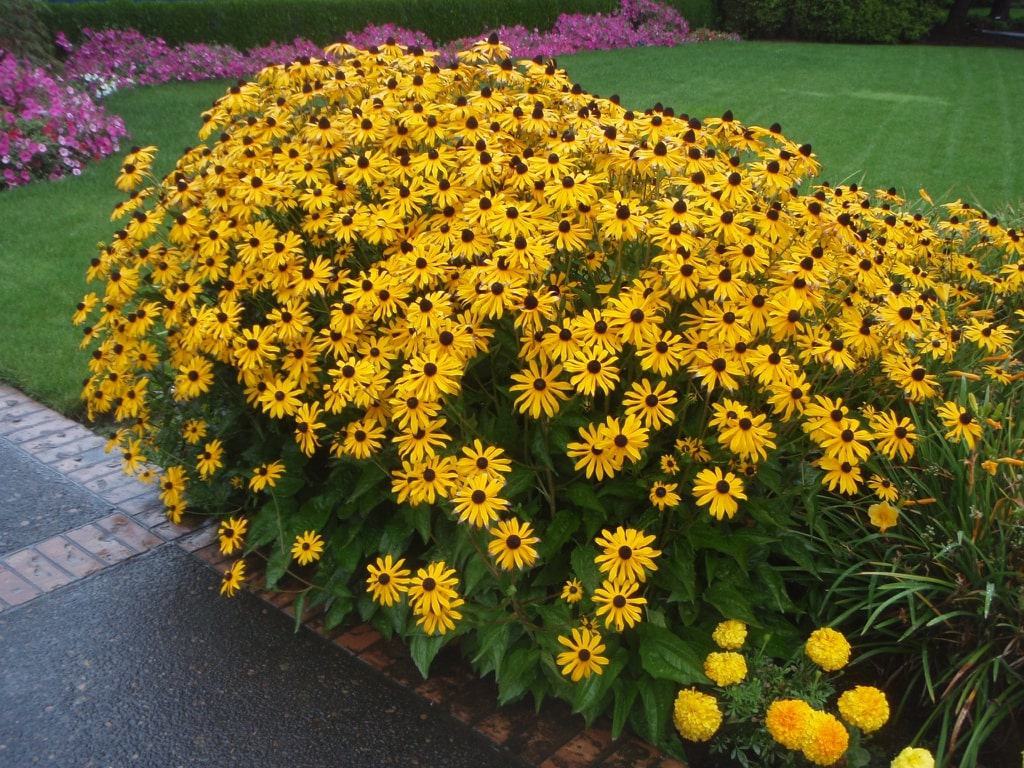
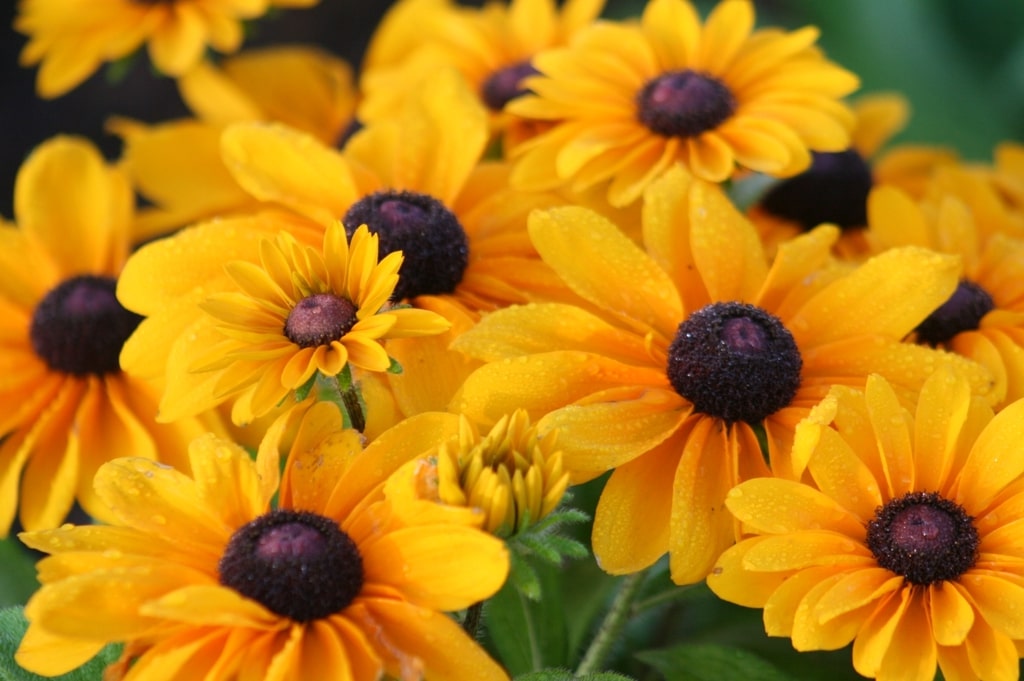
| Scientific Name | Rudbeckia hirta |
| Common Name | Black-eyed Susan, Rudbeckia, and Cone Flowers |
| Weed Type | Perennial weed |
| Flower | Bright yellow flower with dark chocolate-colored center |
| Leaves | Thin, lanceolate shapedSparsely-toothed leaves |
The Black-Eyed Susan is a perennial weed native to gardens, prairies, and meadows of eastern and central North America. It thrives in heat, drought, and in a wide range of well-drained soils.
It produces clusters of daisy-like flowers with a distinct brown center every June to August.
It’s also the state flower of Maryland and the symbol of the University of Southern Mississippi.
13. Canadian Goldenrod (Solidago canadensis)
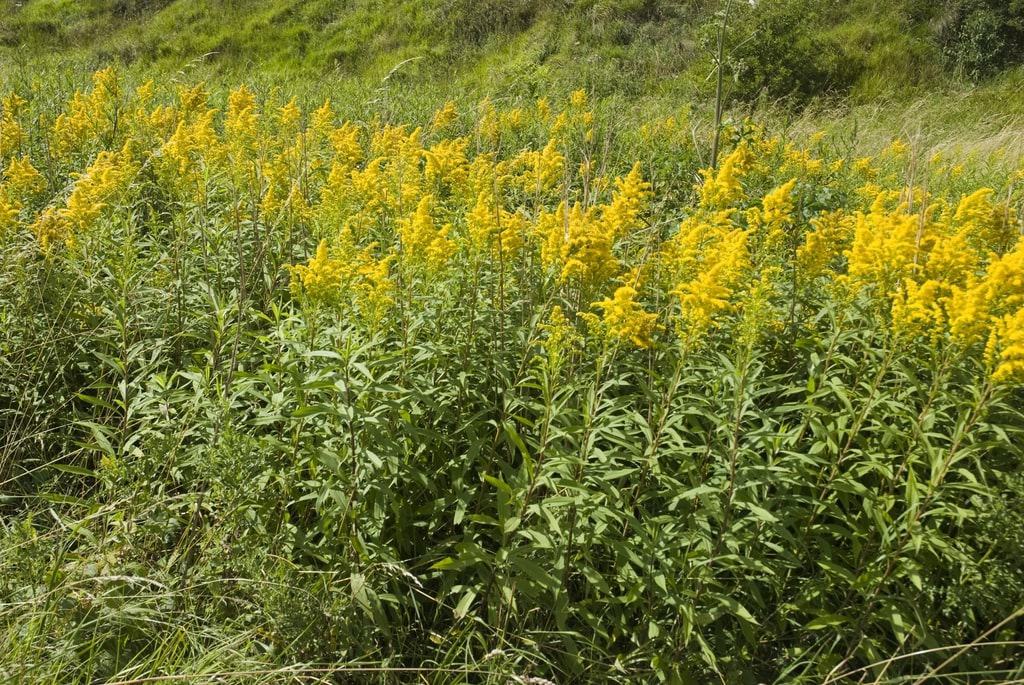
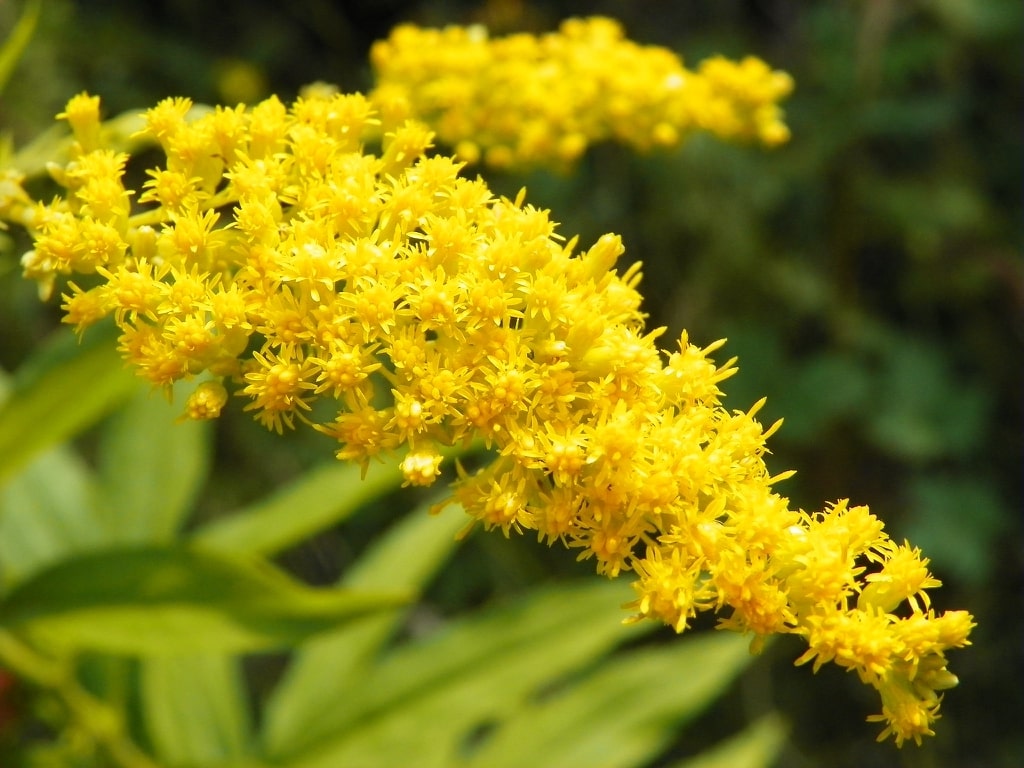
| Scientific Name | Solidago canadensis |
| Common Name | Canadian goldenrod |
| Weed Type | Perennial weed |
| Flower | Tiny yellow flowers in elongated pyramid formation |
| Leaves | Prominently-toothed |
The Canadian goldenrod is a perennial weed that thrives in moist and sunny locations in North America and Europe. They are usually found in savannas, thickets, gravel steeps, and even floodplains.
From August to October, the Solidago it produces tiny yellow flowers in an elongated pyramid formation.
This plant has medicinal properties used for infusions and making sedatives. It is also a go-to source of nectar for bees in the wild.
14. Yellow Evening Primrose (Oenothera biennis)
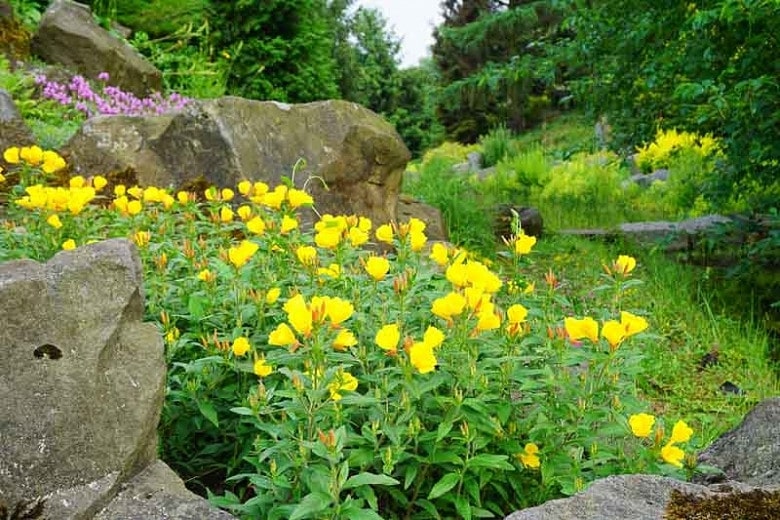
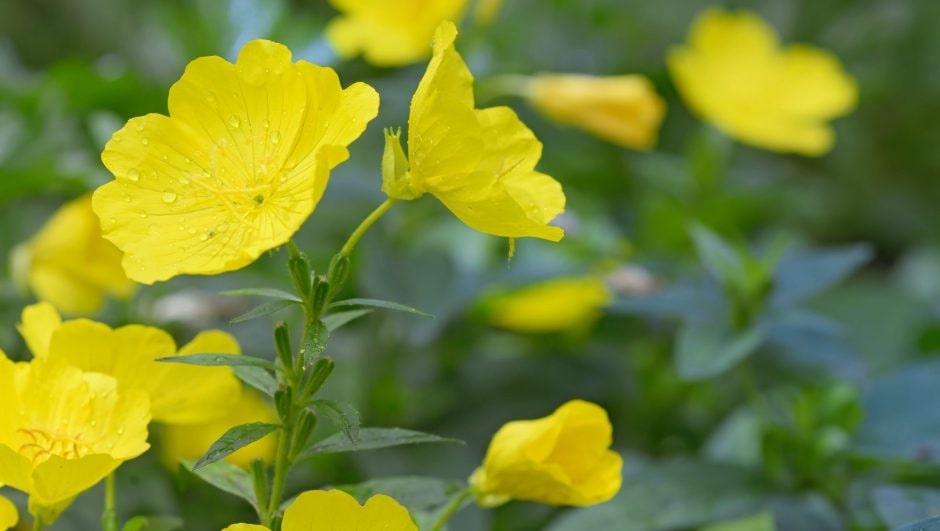
| Scientific Name | Oenothera biennis |
| Common Name | Yellow Evening Primrose, Sundrops, Large Yellow Evening Primrose |
| Weed Type | Biennial weed |
| Flower | Large yellow flower with 4 petals and a cross-shaped stigma |
| Leaves | Oblong, lanceolate leaves |
The Yellow Evening Primrose is a biennial weed that is native to Europe and North America.
It produces flowers that bloom in the evening, hence its common name, Yellow Evening Primrose.
In its first year, this plant grows its leaves and spreads its roots. Afterward, the sundrops produce trumpet-shaped yellow flowers.
Its flower, seed, roots, and essential oil are used to treat fatigue, pre-menstrual syndrome, menopausal problems, and even impotence.
The Yellow Evening Primrose is also a valuable source of nectar for hummingbirds.
15. Creeping Buttercup (Ranunculus repens)
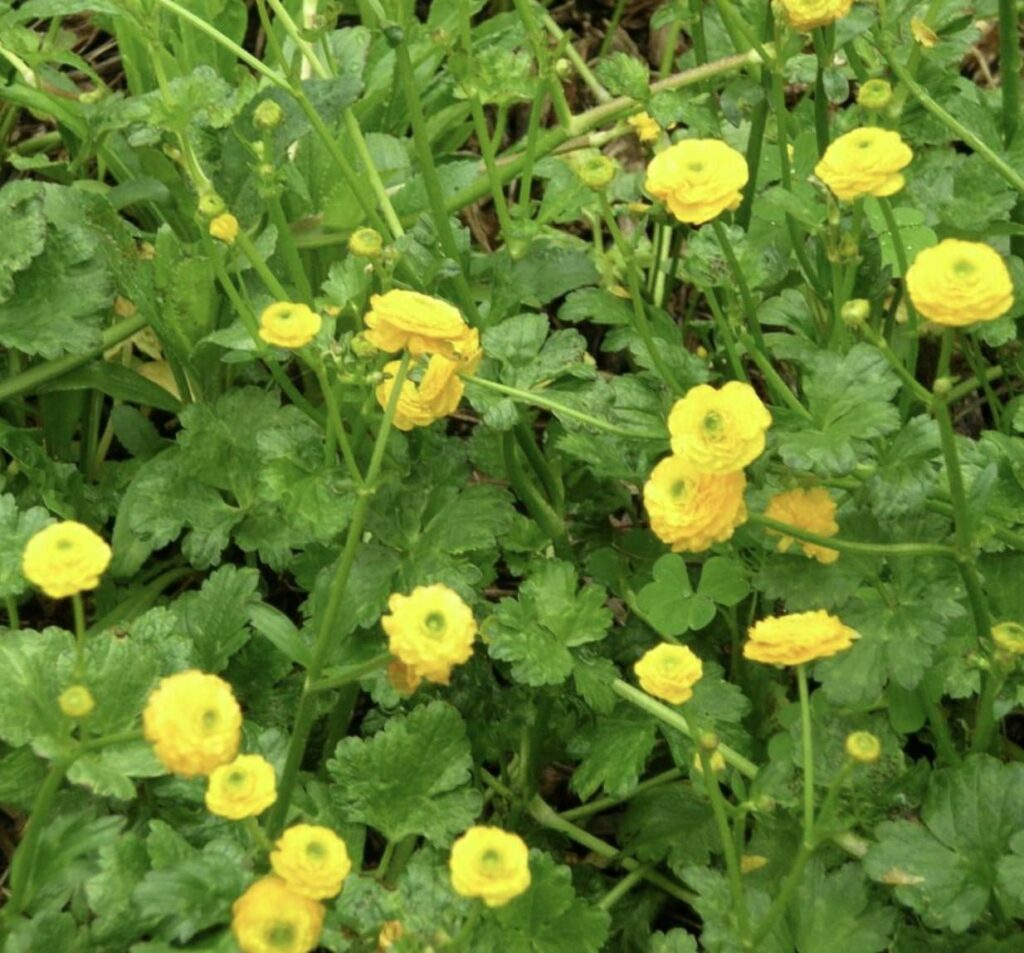
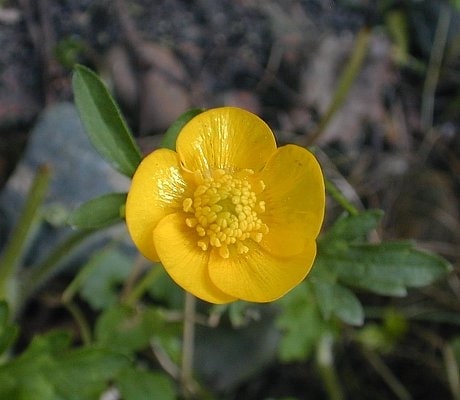
| Scientific Name | Ranunculus repens |
| Common Name | Creeping buttercup, creeping crowfoot, sitfast |
| Weed Type | Perennial weed |
| Flower | Small yellow flower with 5 overlapping petals |
| Leaves | Light green leaves grow on long fine-haired stalks |
The Creeping Buttercup is a low-growing perennial weed. It thrives in wet or damp areas in Europe, Africa, and Asia.
Its flowers have 5 overlapping petals with clusters and stamens at the center and bloom from March to August.
Its hairy stems grow up to one foot tall while its hairy leaves have distinct pale patches and 3 toothed leaflets.
Unfortunately, the Creeping Buttercup crowds out other plants and competes with the nutrients and water in the soil.
This plant is also toxic to grazing animals as it contains the chemical protoanemonin. Animals that ingest this reportedly suffer from skin irritation, abdominal distress, blisters, salivation, and inflammation.
16. Creeping Cinquefoil (Potentilla reptans)
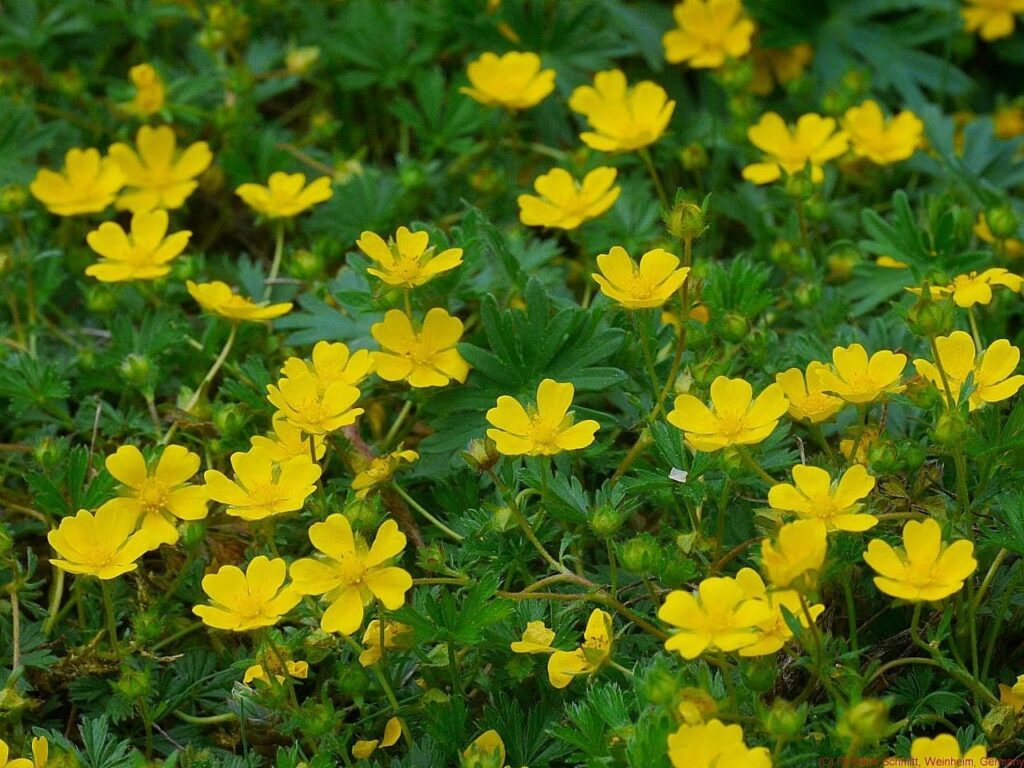
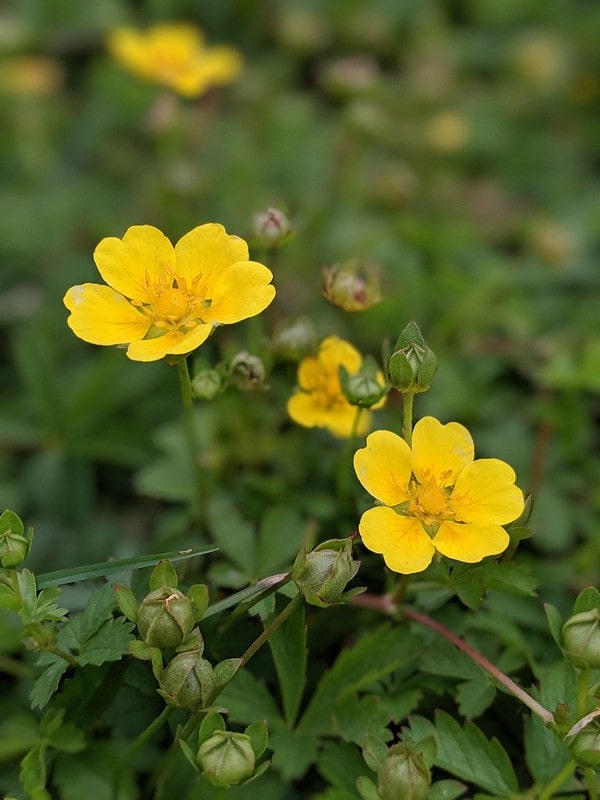
| Scientific Name | Potentilla reptans |
| Common Name | Creeping cinquefoil, European cinquefoil, creeping tormentil, Creeping five-finger |
| Weed Type | Perennial weed |
| Flower | Yellow flower with 5 heart-shaped petals |
| Leaves | Palmate leaves with tooth-edged leaflets |
The Creeping cinquefoil is a member of the rose family and a perennial weed. It is native to Europe, Asia, North Africa, and the United States.
It blooms during early summer, featuring bright flowers that have 5 heart-shaped petals.
This plant also has creeping stems and roots directly from its nodes, making it an invasive type of weed. It can smother plants within a 10 sqm radius in a single season.
17. Cypress Spurge (Euphorbia cyparissias)

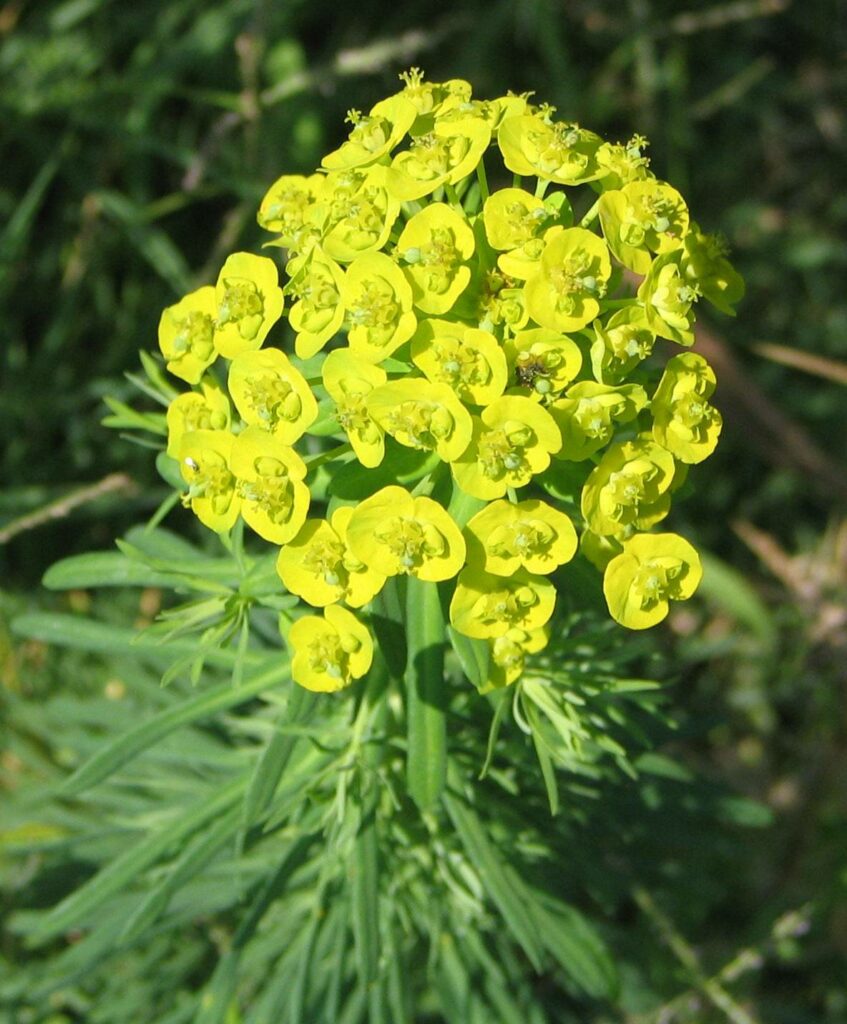
| Scientific Name | Euphorbia cyparissias |
| Common Name | Bonaparte’s Crown, graveyard moss, graveyard weed, and cypress spurge |
| Weed Type | Perennial weed |
| Flower | Tiny yellow flowers in umbel-like clusters |
| Leaves | Narrow leaves with toxic milky sap |
The cypress spurge is a ground-covering perennial weed that is native to Europe and North America.
It thrives in dry, well-drained soils that have full sun exposure. It can tolerate heat and droughts, making it abundant in dry banks and hillsides.
This herbaceous herb has erect stems with cup-shaped yellow flowers at the top.
Its foliage resembles a bottle brush. However, the leaves contain a toxic milky sap that causes poisoning to livestock and skin irritation to humans.
18. Dandelion (Taraxacum officinale)
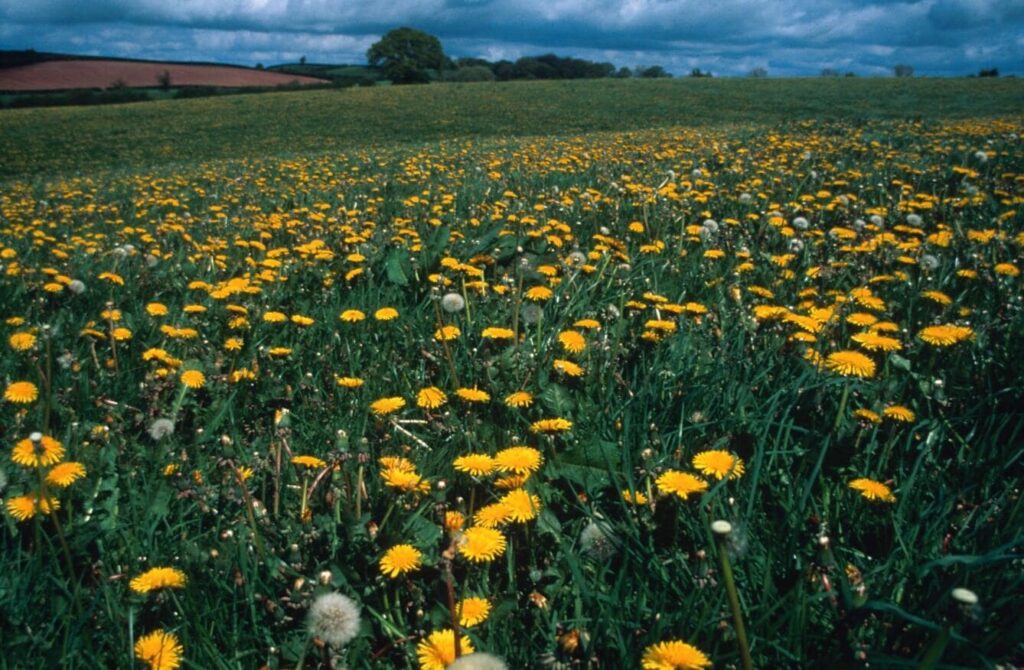
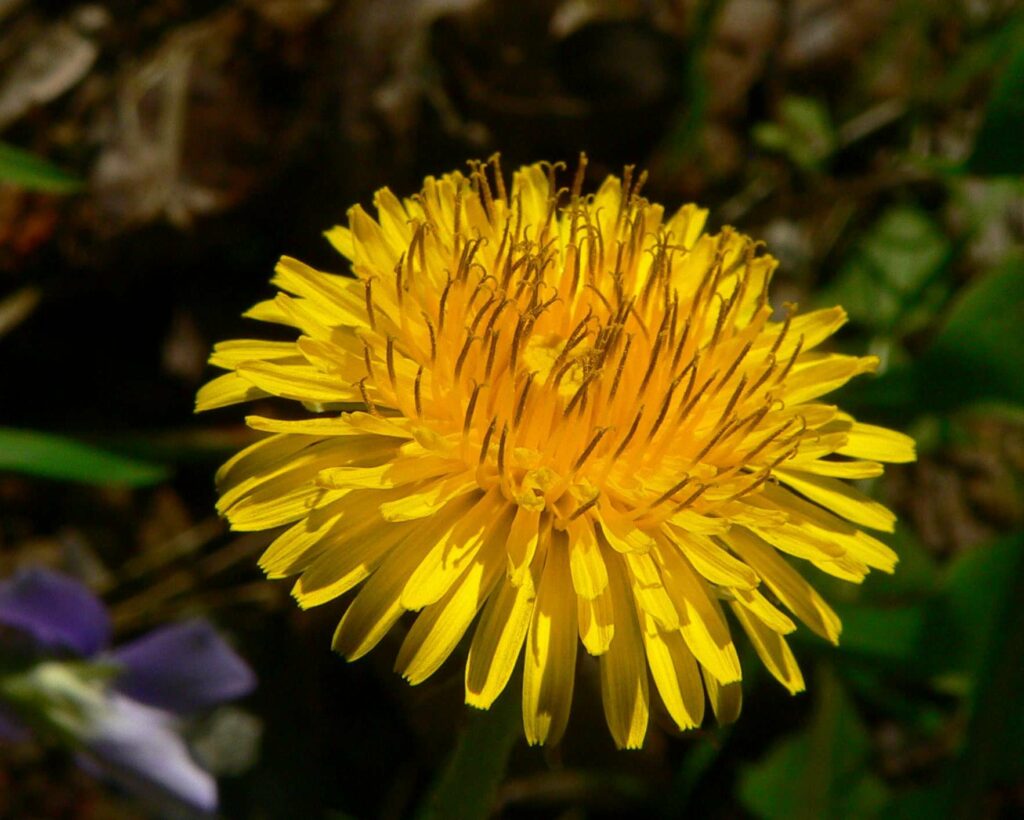
| Scientific Name | Taraxacum officinale |
| Common Name | Dandelion, Lion’s tooth, blow-ball, Irish daisy, pissinlit, puffball, tell-time, yellow gowan |
| Weed Type | Perennial weed |
| Flower | Bright yellow flowers on top of hollow stalks |
| Leaves | Dark green leaves |
Dandelions are one of the most popular yellow flowers that grow from perennial weeds.
It has been a common ritual for children to make a wish before blowing on a dandelion puffball to disperse the seeds.
It is a fast-spreading weed that forms deep in the taproots. It also contains a milky latex sap.
These bright yellow dandelions bloom from March to November.
The leaves, flowers, and roots are edible. Its flowers taste like honey and are used as a natural ingredient in wine, salad, and even jams.
Its foliage can be eaten raw or cooked while the root is a great substitute for coffee.
19. Golden Clover (Trifolium aureum pollich)
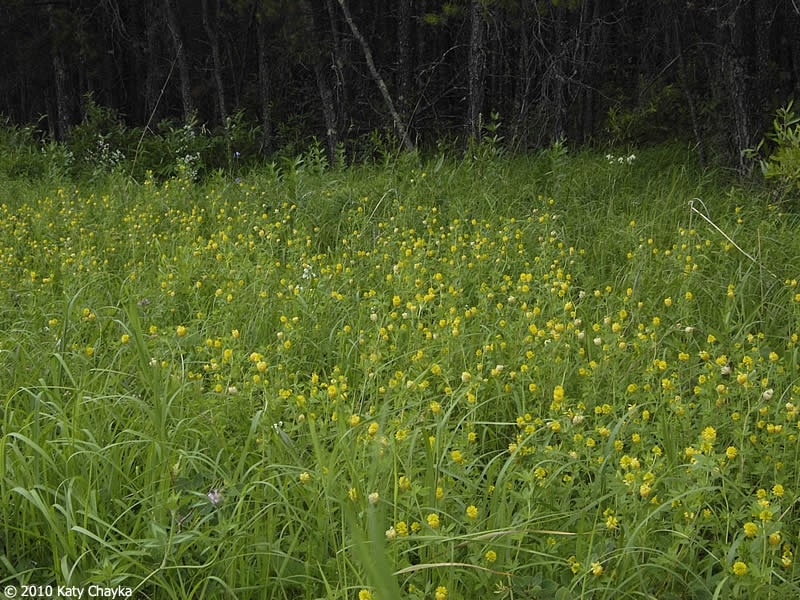
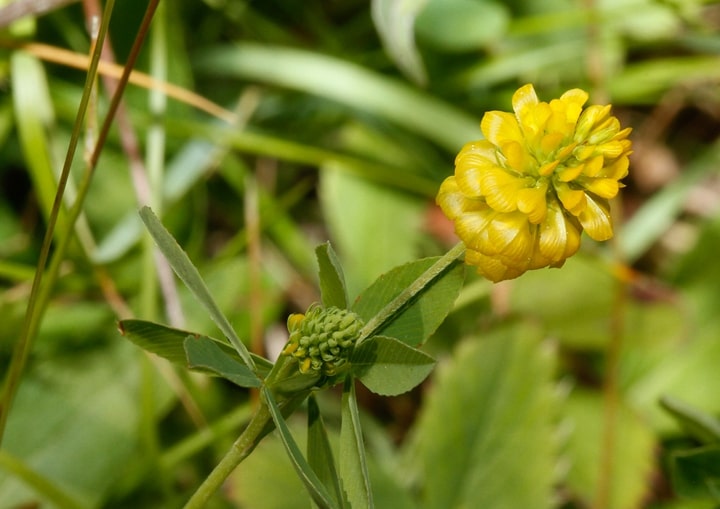
| Scientific Name | Trifolium aureum pollich |
| Common Name | Large hop trefoil, large trefoil, large hop clover, golden clover or hop clover, palmate hop clover |
| Weed Type | Biennial weed |
| Flower | Bright yellow flowers arranged into an elongated inflorescence |
| Leaves | Dark green leaves, each divided into 3 sessile leaflets |
The golden clover is a small biennial weed indigenous to Europe and Asia. It thrives in partly shaded and sun-exposed habitats such as roadsides and forest trails.
Meadows are filled with bright yellow flowers when it blooms from June to August. These flowers are arranged in an elongated round inflorescence at the end of the stem.
They have broad, compound leaves that divide into 3 sessile leaflets.
The golden clover is edible and has been used in salads and teas.
20. Lesser Celandine (Ficaria verna)
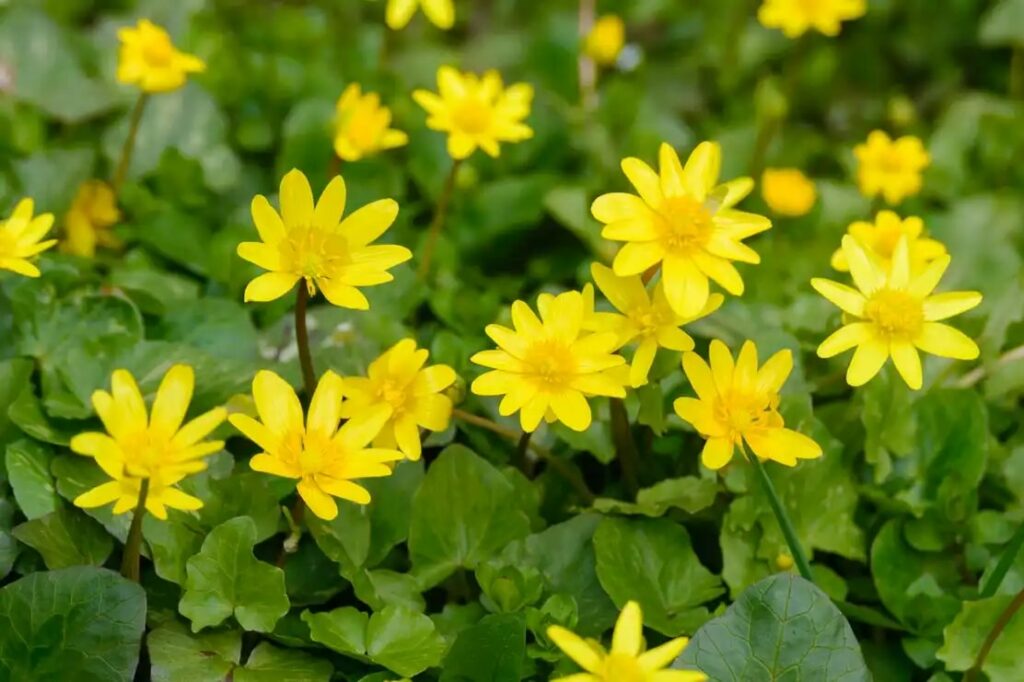
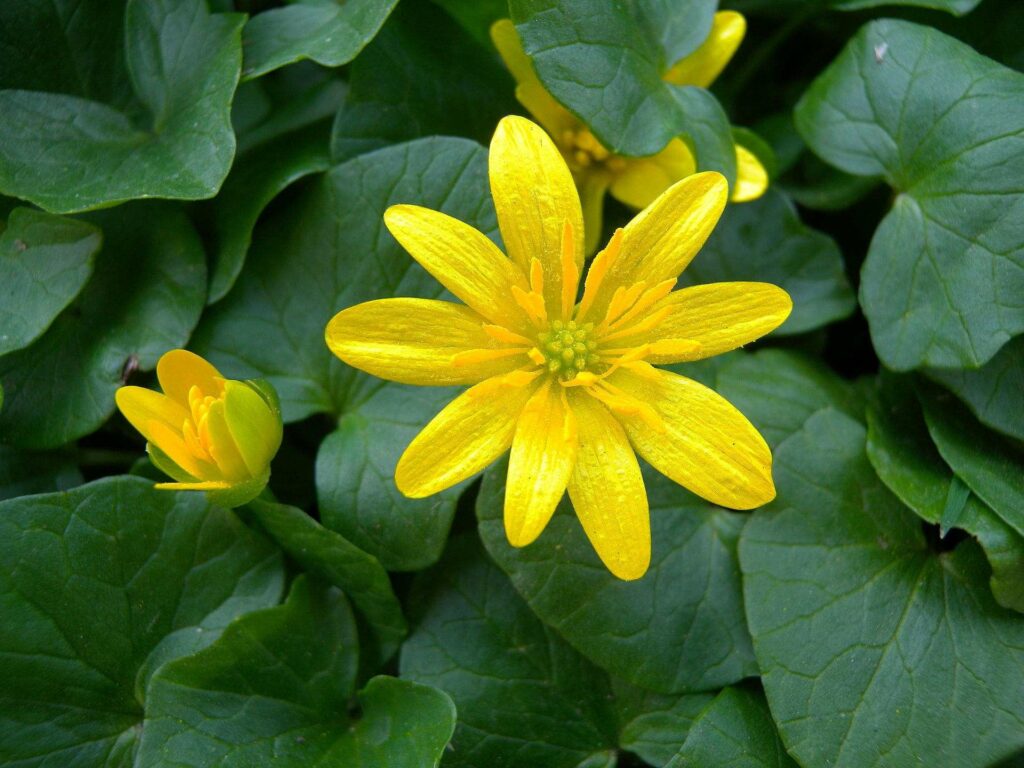
Image: Gardeners’ World (left); Wikipedia (right)
| Scientific Name | Ficaria verna |
| Common Name | Lesser celandine, pilewort |
| Weed Type | Perennial weed |
| Flower | Yellow buttercup-like flower |
| Leaves | Strongly-lobed grayish-green leaves |
The Lesser celandine is a perennial weed native to damp environments in Europe, Asia, and North America.
It has grayish-green leaves shaped like a heart. In early spring, yellow buttercup-like flowers bloom from this weed.
It is a common garden weed that aggressively spreads its root system and is capable of self-pollination.
21. Marsh Yellowcress (Rorippa palustris)

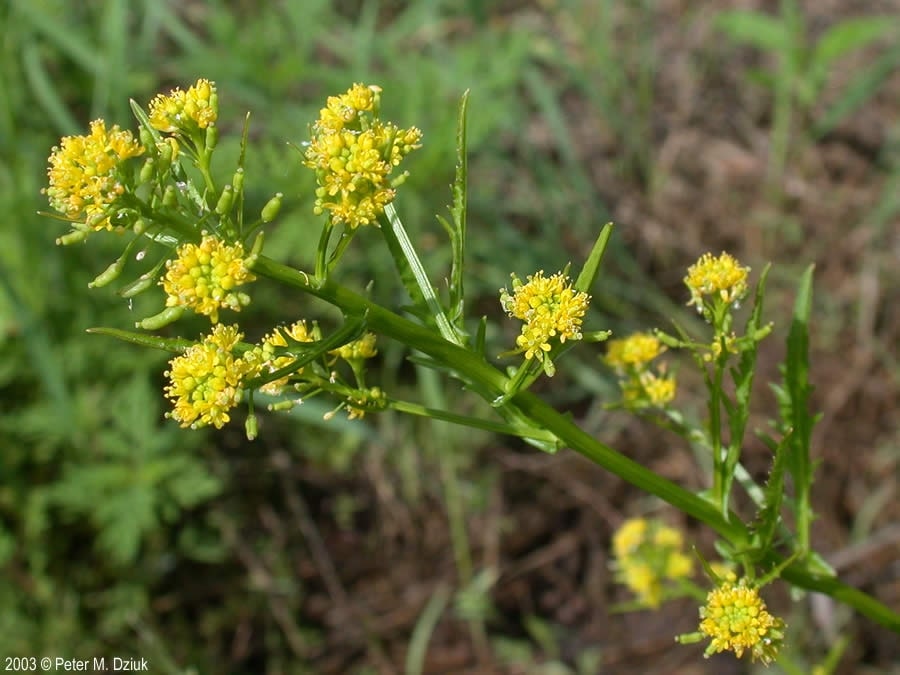
| Scientific Name | Rorippa palustris |
| Common Name | Marsh yellowcress, Bog marsh cress, bog yellowcress, yellow cress, yellow watercress |
| Weed Type | May be annual, biennial or perennial weed |
| Flower | Yellow flower with 4 slender petals in terminal clusters |
| Leaves | Alternate, petiolatedWith lobes at the tip |
The marsh yellowcress may be an annual, biennial or perennial weed, but it certainly grows in moist and wet environments.
It is native to Africa, Asia, Europe, North America, and the Caribbean, but has been naturalized across the globe.
This plant forms a rosette of deeply-lobed leaves. Flower stalks then grow, setting the stage for a bright yellow flower with 4 slender petals in terminal clusters.
22. Narrowleaf Plantain (Plantago lanceolata)


| Scientific Name | Plantago lanceolata |
| Common Name | Ribwort plantain, narrowleaf plantain, English plantain,ribleaf, lamb’s tongue, buckhorn |
| Weed Type | Perennial weed |
| Flower | Furrowed flower stalk with an inflorescence of smaller flowers |
| Leaves | Basal leavesLanceolate spreadingScarcely-toothedParallel veins with a short petiole |
The narrowleaf plantain is a perennial weed from the plantain family Plantaginaceae.
It is native to Europe and Asia and is commonly found in pastures, fields, meadows, and lawns.
The narrowleaf plantain has an oblong-shaped flower stalk at the top with an inflorescence of smaller light yellow flowers.
Its foliage can be eaten cooked or raw. It is used for tea or for the treatment of cough, diarrhea, hematuria, and dysentery.
23. Purslane (Portulaca oleracea)

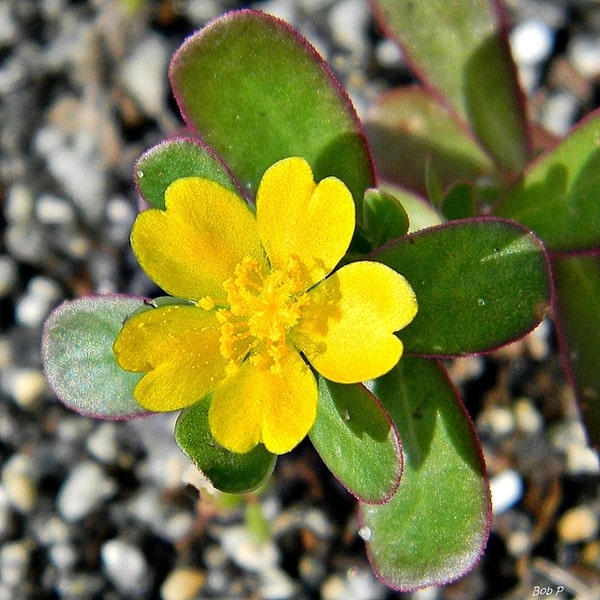
| Scientific Name | Portulaca oleracea |
| Common Name | Common Purslane, Pursley, little hogweed |
| Weed Type | Annual weed |
| Flower | Tiny bright yellow flowers with notched petals |
| Leaves | Alternate, clover-like leaves |
Purslane is an annual weed indigenous to the temperate and tropical regions of northeast United States.
This little succulent is commonly found in pathways, rocky bluffs croplands, barnyards, and nurseries.
It blooms any time of the year with small yellow flowers with 5 heart-shaped petals. It has smooth red stems and alternate, clover-like leaves.
This plant is a good source of food for sparrows, deer, and pigs in the wilderness.
24. Wild Parsnip (Pastinaca sativa)

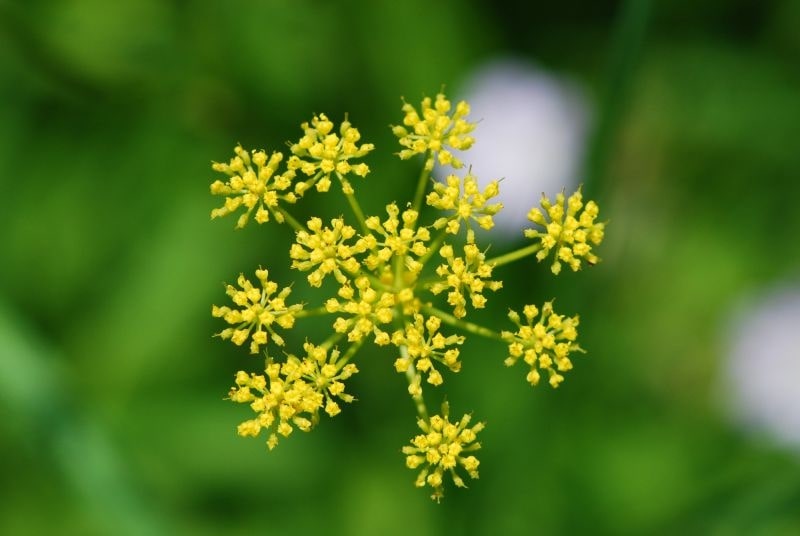
| Scientific Name | Pastinaca sativa |
| Common Name | Wild parsnip, poison parsnip |
| Weed Type | Biennial weed |
| Flower | Small yellow flowers in clusters |
| Leaves | Bright green, alternate leaves |
Wild parsnip is native to Europe, Asia, and the United States. It is usually found on roadsides, forests, and field margins.
Before its roots become edible, wild parsnip plants begin as biennial weeds. It has hollow ribbed stems and bright green alternate leaves with toothed leaflets.
Its flowering season occurs from May to June when small yellow flowers arranged in umbel emerge at the top of its tall stems.
The plant is also called poison parsnip because chemicals from its leaves, stems, and flowers cause blisters, burns, and other types of skin irritation, especially when exposed to sunlight.
25. Wild Radish (Raphanus raphanistrum)
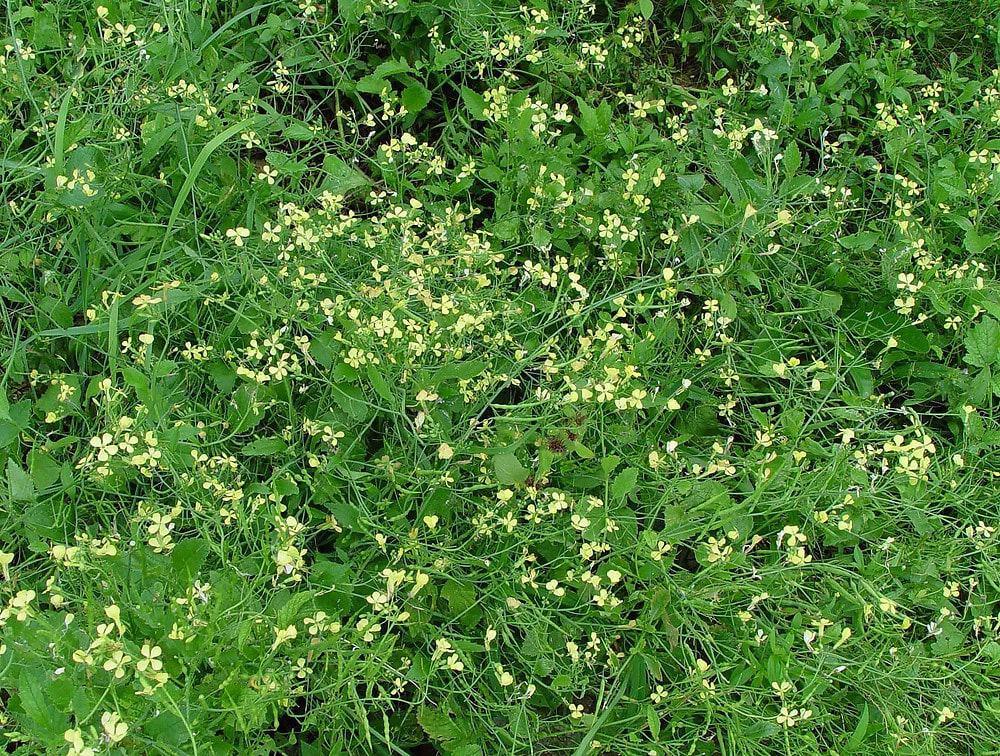
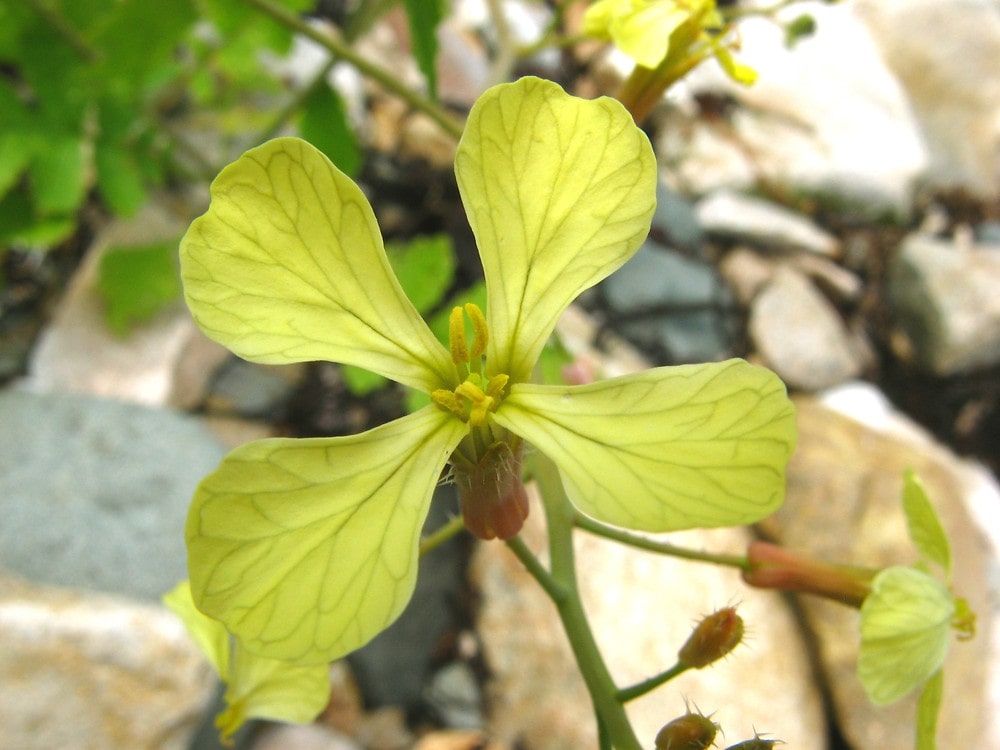
Image: Go Botany
| Scientific Name | Raphanus raphanistrum |
| Common Name | wild radish, white charlock, jointed charlock |
| Weed Type | Annual weed |
| Flower | With 4 yellow petals with dark veins |
| Leaves | Pinnate leaves with a large rounded terminal lobe |
The wild radish is an annual weed from the mustard family. It is native to the temperate regions of North Africa, Europe, and Western Asia.
It thrives in disturbed areas such as roadsides and floodplains.
Wild radish has a rosette of basal lobed leaves at the bottom. Its stems are elongated and covered by the alternate growth of its foliage.
At the tip of each stem emerges a pale yellow flower with 4 petals and dark veins.
The dried ripe seed of wild radish is a common traditional medicine for hypertension and constipation.
26. Yellow Nutsedge (Cyperus esculentus)
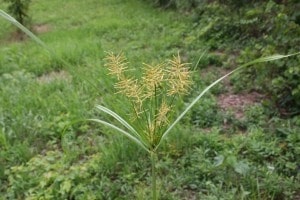
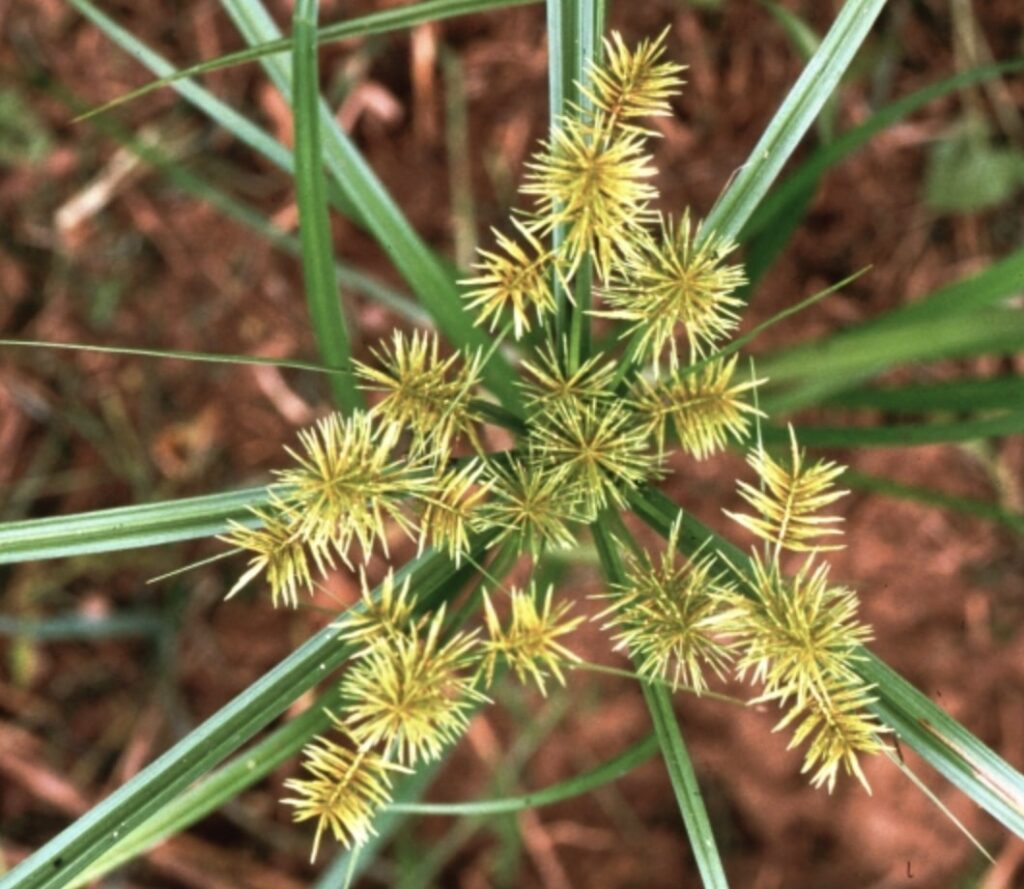
Image: Michigan State University (left); IPM Images (right)
| Scientific Name | Cyperus esculentus |
| Common Name | Chufa, tiger nut, atadwe, yellow nutsedge, earth almond |
| Weed Type | Perennial weed |
| Flower | Yellow spikelets arranged in rays of umbel |
| Leaves | Smooth, shiny, grasslike leaves |
The yellow nutsedge is a perennial weed native to North and South America, Europe, Asia, and Africa. It is usually found on upland prairies, ponds, stream edges, pastures, fields, roadsides, railroads, and moist open areas.
This plant grows up to 2 feet tall making its yellow spikelets flowers arranged in umbel easily visible.
This grasslike native weed spreads through rhizomes and tubers and thrives in moist and wet environments.
The yellow nutsedge is a noxious invasive weed that tends to rob surrounding plants of water and nutrients through its roots.
27. Yellow Salsify (Tragopogon dubius)
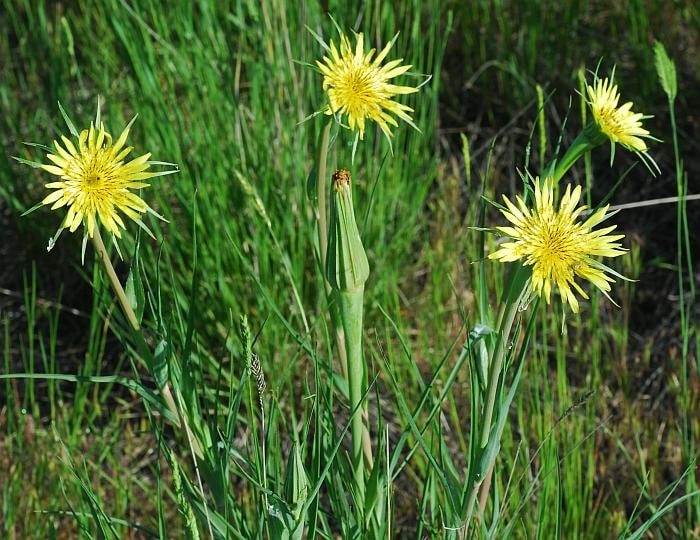
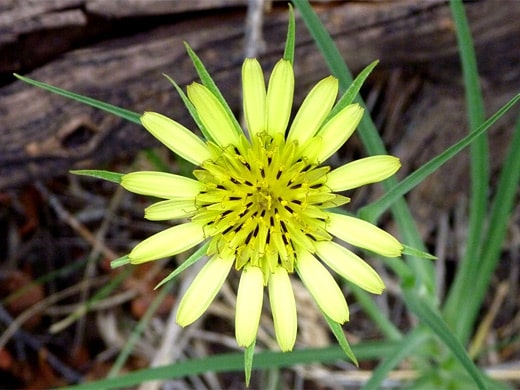
Image: Missouri Plants (left); The American Southwest (right)
| Scientific Name | Tragopogon dubius |
| Common Name | Yellow salsify, Western goat’s-beard, wild oyster plant, western salsify |
| Weed Type | Biennial weed |
| Flower | Inflorescence with yellow flowers |
| Leaves | Alternate, lanceolate with smooth pointed tips |
The yellow salsify is a biennial weed native to Europe, Asia, and the United States. It typically grows in warm, moist soils present in woodland, forest, shrubland, and grassland.
Its foliage tends to be alternate and lanceolate with pointed tips.
It blooms from late spring to mid-summer. By this time, an inflorescence of yellow flowers is seen on top of its long hairless stalk.
In each inflorescence, there are smaller inner florets and thinner but longer outer florets surrounding them. At the center are black anthers that give this flower its distinct feature.
28. Yellow Sorrel (Oxalis stricta)
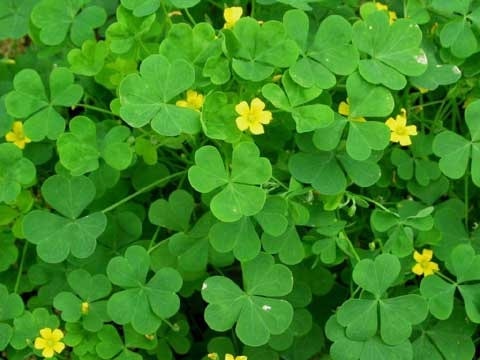

| Scientific Name | Oxalis stricta |
| Common Name | Wood sorrels, yellow sorrels, sour grasses, false shamrocks |
| Weed Type | Perennial weed |
| Flower | Tiny yellow flowers with 5 petals |
| Leaves | Dark green clover leaves |
The yellow sorrel is a perennial weed common in Brazil, Mexico, and South Africa. It is usually found in pastures, flower beds, lawns, woodlands, meadows, and even disturbed areas.
It blooms with a small bright yellow flower with 5 petals. Surrounding it are its trifoliate heart-shaped leaves that curl up at night and open every morning.
This plant propagates through its rhizomes and stolons, making it an aggressive weed in gardens.
29. Black Medic (Medicago lupulina)
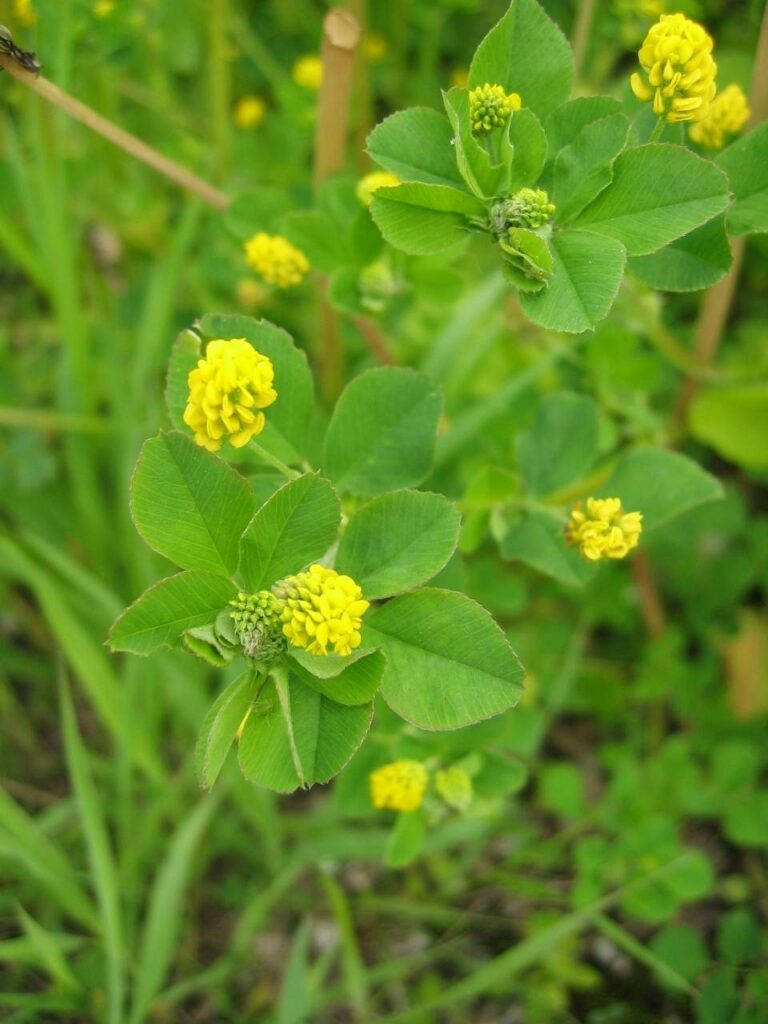

Image: Feedipedia (left); Gardening Know How (right)
| Scientific Name | Medicago lupulina |
| Common Name | Black medic, nonesuch, hop clover, black clover |
| Weed Type | Annual weed |
| Flower | Small yellow flower in tight bunches |
| Leaves | Compound leaves3 oval leafletsShort petioles |
The black medic is a weed native to the disturbed areas, lawns and pastures of Europe, North Africa, and Asia. It thrives in dry and well-drained soils.
It produces small yellow flowers in tight bunches emerging from the leaves. Each globe-like flower head contains 15 to 50 smaller yellow flowers.
This is an aggressive weed that uses its branched taproot and nodules to propagate. In the process, the black medic also adds nitrogen to the soil.
Which of these plants have you encountered before? Do you know any other yellow flowers that are actually weeds?
Let us know in the comment box below!




